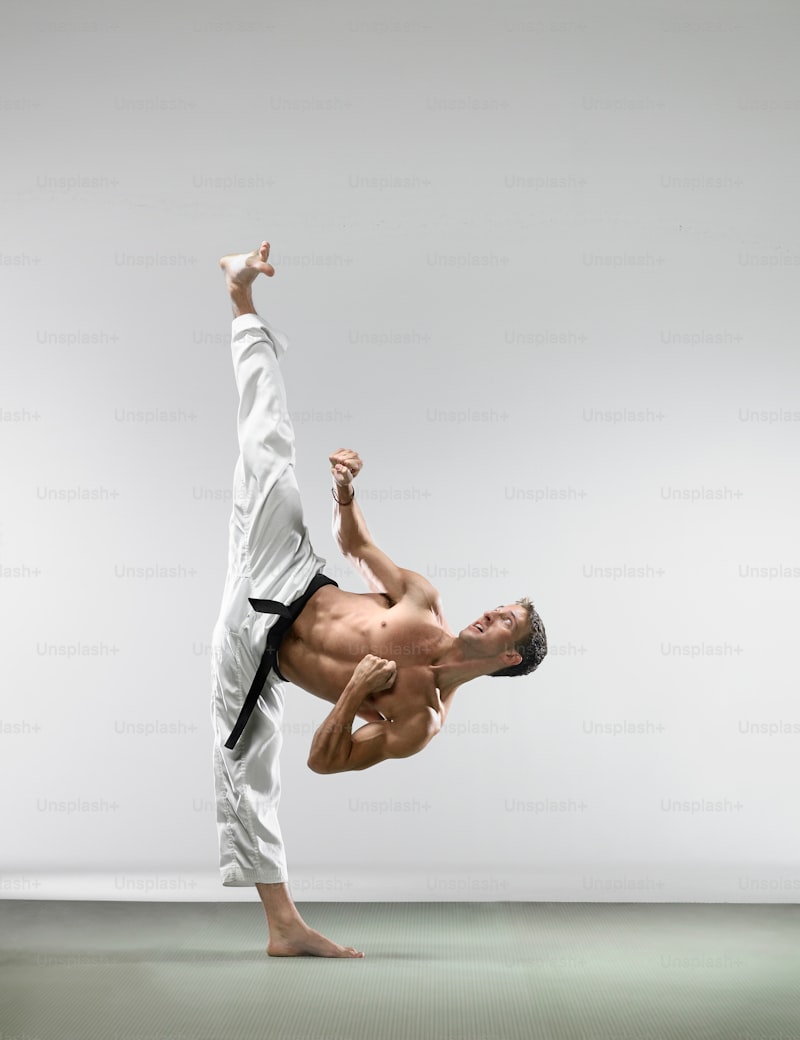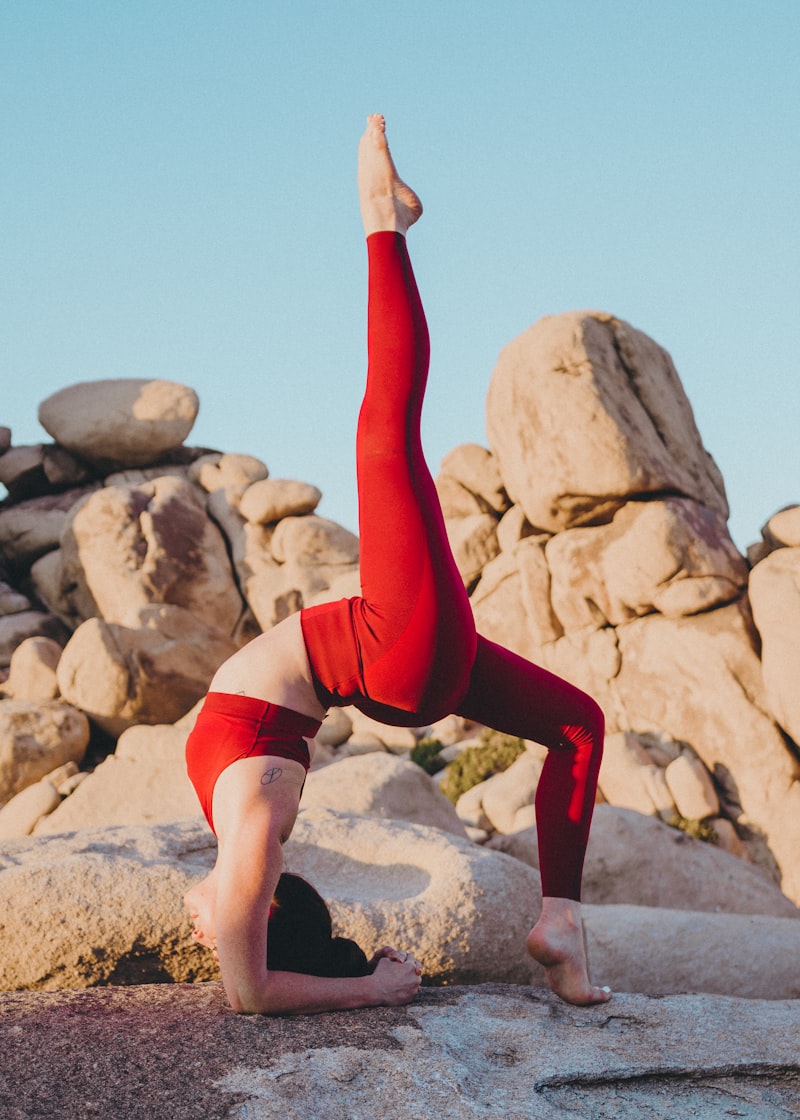Take the plank pose, for example. This seemingly straightforward pose requires you to support your body’s weight on your hands and toes while maintaining a straight line from head to heels. Holding this position engages your core muscles, shoulders, arms, and legs, effectively toning and strengthening them over time. It’s like holding a perfect plank of wood – steady, balanced, and unwavering.
Then there’s the warrior pose series, which includes poses like Warrior I, II, and III. These poses challenge your leg muscles, enhancing their strength and stability. Picture a warrior standing firm and ready for battle – these poses emulate that strength and determination, building muscles in your thighs, calves, and ankles while improving overall balance and coordination.
For those looking to sculpt their upper body, the downward-facing dog pose can work wonders. This pose targets your arms, shoulders, and upper back, providing a great stretch while also strengthening these areas. It’s akin to pushing away from the ground like a playful dog, stretching out and building strength with each movement.
Moreover, yoga’s focus on body awareness and control means you’re not just building muscles blindly. Each pose requires concentration and mindful engagement of specific muscle groups, ensuring a holistic approach to strength building. It’s not just about lifting weights; it’s about understanding and connecting with your body’s capabilities in a profound way.
Beyond Flexibility: How Yoga Can Transform Muscle Power and Endurance
When you dive into yoga, you’re not just holding poses; you’re engaging your muscles in ways you might not with typical gym workouts. Each pose requires strength, stability, and balance, turning your body into a powerhouse of endurance. For instance, holding a plank or warrior pose demands more than just flexibility. It engages your core, strengthens your legs, and challenges your upper body. Over time, this practice builds muscle endurance and power, making those push-ups or squats in the gym feel like a breeze.
Consider the downward dog position. It’s a classic yoga move, but it does wonders for your arms, shoulders, and back. It’s like a full-body workout wrapped in one pose. The more you practice, the more you’ll notice improvements in muscle strength and stamina, which translates into better performance in other physical activities.
But it’s not just about raw muscle power. Yoga improves your muscle endurance by promoting a deep connection between your breath and movement. This enhanced breath control ensures that your muscles get the oxygen they need to keep going, which means you can push through longer workouts without hitting the wall.
So, if you’re looking to transform your workout routine, adding yoga could be your game changer. It’s more than just stretching; it’s a way to build a resilient, powerful body that can handle anything you throw at it. Give it a try, and you might just find yourself surprised at how strong and enduring your muscles can become.
Unlocking Inner Strength: Yoga’s Impact on Physical Fitness Revealed
Have you ever wondered how yoga can transform not just your body, but also your mind and soul? Let’s dive into the profound impact yoga has on physical fitness and overall well-being.
Yoga isn’t just about stretching on a mat; it’s a holistic practice that integrates breathing techniques, meditation, and various postures to enhance strength, flexibility, and mental clarity. Imagine it as a journey where each pose unlocks a new level of inner strength and balance.
One of the most remarkable aspects of yoga is its ability to sculpt your physique without the need for heavy weights or intense cardio. Through a series of poses like Downward Dog, Warrior I, and Tree Pose, you engage muscles you didn’t even know existed. It’s like sculpting a masterpiece with your own body as the canvas.
Beyond physical appearance, yoga nurtures your inner resilience. It teaches you to breathe through discomfort, finding calmness in challenging poses and life’s daily stresses alike. This mental fortitude translates into real-life situations, making you more resilient and adaptable.
Moreover, yoga is accessible to everyone, regardless of age or fitness level. Whether you’re a beginner or a seasoned yogi, there’s always a variation or modification that suits your needs. It’s about progress, not perfection, fostering a sense of achievement with every practice.
As you delve deeper into your yoga journey, you’ll notice subtle yet profound changes. Your posture improves, muscles become toned yet supple, and you gain a newfound sense of energy and vitality. It’s like unlocking a treasure trove of health benefits that extend far beyond the physical realm.
From Downward Dog to Power Lifts: Yoga’s Surprising Influence on Muscle Growth
When we think of muscle growth, weightlifting typically comes to mind. However, yoga’s unique blend of isometric holds, dynamic movements, and deep stretches engages muscles in ways that traditional weightlifting alone might not. Poses like Downward Dog may seem simple, but holding this position requires significant upper body strength and stability. It engages muscles from the shoulders to the calves, promoting endurance and toning.
Moreover, yoga incorporates various styles such as Power Yoga or Ashtanga Yoga, which emphasize continuous movement and strength-building postures. These styles challenge muscles through repetitive motions and sustained holds, effectively promoting muscle hypertrophy – the growth of muscle cells.
Unlike the quick, explosive movements of powerlifting, yoga focuses on controlled movements and breath work, which enhances overall muscle control and balance. This holistic approach not only aids in muscle development but also reduces the risk of injury by improving flexibility and joint mobility.
Imagine your muscles as a rubber band – yoga stretches and lengthens them, improving elasticity and range of motion. This suppleness not only prevents injuries during weightlifting but also enhances muscle recovery and overall performance.
Incorporating yoga into your fitness routine doesn’t mean giving up heavy lifting. On the contrary, it complements traditional strength training by improving muscle strength, endurance, and flexibility. Whether you’re a seasoned lifter or just starting out, adding yoga can help you achieve a more balanced, functional physique.
Next time you hit the gym, consider the benefits of integrating yoga into your workout regimen. From enhancing muscle growth to improving flexibility and preventing injuries, yoga’s influence on strength training goes beyond the mat – it transforms the way your muscles work and perform.
Strength Within Serenity: Yoga’s Contribution to Athletes’ Peak Performance
Imagine a marathon runner, her stride effortless and precise. What if I told you that behind that seamless motion lies the quiet power of yoga? Yoga isn’t just about touching your toes; it’s about what you learn on the way down. Athletes who embrace yoga discover that it’s not just a workout – it’s a pathway to unlock hidden reserves of strength, focus, and resilience.
At its core, yoga cultivates a deep connection between mind and body. Through a series of poses and controlled breathing exercises, athletes develop a heightened awareness of their physicality. This mindfulness extends beyond the yoga mat, allowing athletes to stay present in the heat of competition, making split-second decisions with clarity and composure.

The benefits of yoga extend far beyond flexibility. It builds functional strength, targeting muscles often overlooked in traditional training regimens. For athletes, this means fewer injuries and greater overall stability. Picture a tree firmly rooted in the ground, its branches swaying gracefully in the wind. Similarly, yoga creates a foundation of stability that allows athletes to perform at their peak without compromising their bodies.
Moreover, yoga offers a sanctuary from the relentless demands of training and competition. In a world fueled by adrenaline and competition, yoga provides a space for athletes to recharge and find balance. It’s a reminder that sometimes, the path to peak performance isn’t always about pushing harder – it’s about finding strength within serenity.
Harnessing Yoga for Muscular Development: Science Meets Ancient Practice
At its core, yoga combines various postures (asanas) that engage different muscle groups. These poses not only stretch and lengthen muscles but also require them to contract and stabilize. Take the Warrior poses, for instance. They not only build leg strength but also engage the core and upper body, creating a holistic muscle-building effect.
What makes yoga unique is its emphasis on bodyweight resistance. Unlike traditional weightlifting that uses external weights, yoga utilizes your body as the primary tool for resistance. This approach not only tones muscles but also improves endurance and flexibility simultaneously.
From a scientific standpoint, yoga triggers muscle hypertrophy—the growth and increase in size of muscle cells—through consistent practice. When muscles are subjected to controlled stress (as in yoga poses), micro-tears occur within the muscle fibers. As these tears repair, muscles become stronger and more defined over time.

Moreover, yoga promotes muscle balance and symmetry. By working on both large and small muscle groups, yoga helps prevent muscular imbalances that can lead to injuries in other forms of exercise. This balanced approach fosters overall strength and stability in the body, enhancing performance in various activities and sports.
The New Gym Regime: Yoga’s Rise as a Strength Training Essential
Imagine this: you’re holding a plank position, feeling the burn in your core, and you realize it’s not just about enduring the discomfort but also about the control and balance that yoga demands. That’s the magic of incorporating yoga into your gym regime—it challenges your muscles in new ways, leading to better functional strength and stability.
In the past, yoga might have been seen as something you do on your rest days or after a tough workout to stretch out. Now, it’s becoming clear that yoga itself can be a challenging workout. Positions like downward dog or warrior poses engage muscles deeply, requiring you to support your body weight while maintaining proper alignment.
What’s fascinating is how yoga seamlessly integrates with traditional strength training. It complements weightlifting by improving flexibility and promoting muscle recovery. Picture this synergy like a dance between flexibility and strength—each supporting the other to create a more balanced and resilient body.
Moreover, yoga isn’t just about physical strength; it enhances mental fortitude as well. The focus on breath control and mindfulness during practice can translate into better concentration and endurance during intense workouts. It’s like training your mind to stay calm under pressure, much like a seasoned athlete in the midst of a challenging match.
As more athletes and fitness enthusiasts embrace yoga, gyms are adapting too. You’ll find dedicated yoga classes tailored specifically for strength training goals, blending traditional poses with dynamic movements to keep your muscles guessing and growing.
Yoga and Weightlifting: Complementary Practices for Building Power
Firstly, weightlifting is fantastic for building muscle mass and raw power. It’s all about lifting heavy weights to challenge your muscles and promote hypertrophy. But here’s the catch – intense weightlifting sessions can leave your muscles tight and your joints feeling stiff.
Enter yoga, the ancient practice known for its flexibility and mindfulness benefits. Yoga involves a series of poses and stretches that promote flexibility, improve mobility, and enhance overall body awareness. By practicing yoga regularly, you can counteract the tightening effects of weightlifting, keeping your muscles supple and your joints agile.
Moreover, yoga isn’t just about stretching – it also builds strength. Many yoga poses require significant muscular engagement, especially in the core, arms, and legs. This added strength can support your weightlifting efforts by stabilizing your muscles and improving your lifting technique.
Imagine your body as a finely tuned machine: weightlifting hones the engine’s power, while yoga ensures the chassis remains flexible and well-maintained. Just as a car needs both a robust engine and a flexible frame to perform optimally, your body benefits from the dual approach of strength training and yoga practice.
Another key benefit of combining yoga with weightlifting is injury prevention. Yoga helps correct muscular imbalances, improves posture, and enhances body awareness, all of which reduce the risk of injury during weightlifting sessions. A body that’s both strong and flexible is less likely to suffer strains or sprains when lifting heavy weights.
So, whether you’re a seasoned weightlifter looking to enhance your performance or a newcomer aiming to build strength safely, integrating yoga into your fitness routine can amplify your results. Embrace the synergy between these two practices and watch as your power, flexibility, and overall fitness soar to new heights.
Frequently Asked Questions
How often should one practice yoga to see improvements in physical strength?
To see improvements in physical strength through yoga, consistency is key. Practicing yoga at least 2-3 times per week is recommended. This frequency allows the body to adapt and strengthen muscles gradually over time.
Can yoga alone replace traditional strength training exercises?
Discover if yoga can fully replace traditional strength training exercises. Learn about the benefits and limitations of yoga compared to strength training, helping you decide the best approach for your fitness goals.
How does yoga improve muscle tone and endurance?
Yoga enhances muscle tone and endurance by incorporating various poses that engage and strengthen different muscle groups. Regular practice improves muscle flexibility and stamina through controlled movements and sustained holds, leading to increased strength and endurance over time.
What are the key yoga poses that help build physical strength?
Discover essential yoga poses designed to enhance physical strength. Learn effective techniques such as Warrior poses (like Warrior I and II), Plank pose, Boat pose, and Chair pose. These postures focus on strengthening major muscle groups, improving endurance, and enhancing overall body stability.
What are the benefits of combining yoga with weight training for strength?
Discover how combining yoga with weight training enhances strength gains and flexibility. Yoga promotes flexibility, balance, and mental focus, complementing the muscle-building benefits of weight training. Together, they improve overall fitness, reduce injury risk, and enhance recovery.


